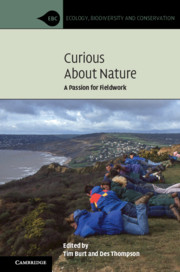Book contents
- Curious About Nature
- Ecology, Biodiversity and Conservation
- Curious About Nature
- Copyright page
- Dedication
- Contents
- Preface
- Foreword
- Part I Getting Curious About Nature
- 1 Fieldwork and Nature: Observing, Experimenting and Thinking
- 2 The Place of Field Studies in Environmental Science
- 3 The History of Fieldwork in the Geosciences
- 4 Pioneering Fieldwork Heroes in the Life Sciences
- 5 The Educational Benefits of Out-of-Classroom Learning
- Part II Essays: Inspiring Fieldwork
- Part III Reflections and Where Next for Field Studies
- Contributing Author Biographies
- Index
- References
3 - The History of Fieldwork in the Geosciences
from Part I - Getting Curious About Nature
Published online by Cambridge University Press: 11 February 2020
- Curious About Nature
- Ecology, Biodiversity and Conservation
- Curious About Nature
- Copyright page
- Dedication
- Contents
- Preface
- Foreword
- Part I Getting Curious About Nature
- 1 Fieldwork and Nature: Observing, Experimenting and Thinking
- 2 The Place of Field Studies in Environmental Science
- 3 The History of Fieldwork in the Geosciences
- 4 Pioneering Fieldwork Heroes in the Life Sciences
- 5 The Educational Benefits of Out-of-Classroom Learning
- Part II Essays: Inspiring Fieldwork
- Part III Reflections and Where Next for Field Studies
- Contributing Author Biographies
- Index
- References
Summary
For much of its history, geography has been very largely a field science, and while today there is an increasing weight placed upon such modern technologies as computer modelling and remote sensing, fieldwork continues to be a major approach to the subject and a fundamental source of many types of inspiration and of data. It is not an exaggeration to say that many of the most significant and influential themes in physical geography and across the geophysical sciences more broadly resulted from the labours of scientists who undertook sustained programmes of work in the field. Among the themes to which one can point with pride are the ideas of Alexander von Humboldt on the indivisibility of nature, Louis Agassiz’s discovery of the Ice Age, Charles Darwin’s work on both the evolution of species and the development of coral reefs, the work of American geologists in the opening up of the American West and the development of ideas on erosion and slope evolution, Baron von Richthofen’s discovery of the true origin of loess, William Morris Davis’s elaboration of the concept of the cycle of erosion, Ellsworth Huntington’s discovery of evidence of climate change in central Asia and its role in driving human history (which led on to environmental determinism), Roy Chapman Andrews’s discovery of dinosaur eggs in Mongolia and Ralph Bagnold’s work on the fundamentals of wind movement of sand and the formation of sand dunes in deserts.
- Type
- Chapter
- Information
- Curious about NatureA Passion for Fieldwork, pp. 66 - 86Publisher: Cambridge University PressPrint publication year: 2020

